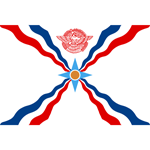Assyrian New Year (Kha b-Nisan) Date in the current year: April 1, 2026
 Assyrian New Year, also known as Kha b-Nisan, Ha b-Nison, Ha b-Nisin or Resha d-Sheta, occurs on April 1 every year. Rooted in the ancient Mesopotamian religion, it is celebrated by the Assyrian diaspora across the world.
Assyrian New Year, also known as Kha b-Nisan, Ha b-Nison, Ha b-Nisin or Resha d-Sheta, occurs on April 1 every year. Rooted in the ancient Mesopotamian religion, it is celebrated by the Assyrian diaspora across the world.Assyrians are an ethnic group indigenous to Mesopotamia, a historical region in the Middle East. Historically, they became a separate ethnic group after adopting Christianity, which helped them separate themselves from their Zoroastrian, Muslim and Jewish neighbors. Due to their adoption of Christianity, the Assyrians have been persecuted for centuries.
By the early 20th century, most Assyrians lived in the Ottoman Empire, Persia and Russian Transcaucasia. During the First World War, hundreds of thousands of Ottoman and Persian Assyrians were slaughtered in the Assyrian genocide. Since then, many surviving Assyrians have migrated to other regions of the world to avoid ethnic and religious persecution.
The Assyrian homeland includes parts of northern Iraq, northeastern Syria, northwestern Iran and southeastern Turkey. Today, sizable Assyrian populations only remain in Iraq and Syria, while Assyrian populations in Iran and Turkey are small. Outside the Assyrian homeland, there are sizable Assyrian communities in the United States, Sweden, Germany, Lebanon, Australia, Jordan, Canada, the Netherlands, France, Russia, and some other countries.
Since Assyrians are a stateless nation, the preservation of culture and tradition is especially important to them as a people. The celebration of the Assyrian New Year, for example, is one of the traditions that unite Assyrians throughout the world, no matter where they live.
The Assyrian New Year falls on April 1. It has two main names: Kha b-Nisan means “first of April” and Resha d-Sheta means “head of the year”, similarly to the Jewish Rosh Hashanah. The holiday has its roots in the ancient Mesopotamian spring festival named Akitu. It is also believed to be related to Nowruz, a festival with Iranian and Zoroastrian origins celebrated worldwide by various ethno-linguistic groups.
Like Nowruz, the Assyrian New Year used to be celebrated on the day of the vernal equinox. However, in the Julian calendar that Assyrians used, the vernal equinox moved gradually from March 21 to April 1. When Assyrians switched to the Gregorian calendar, the Assyrian New Year remained fixed at April 1 instead of being moved back to the actual day of the vernal equinox.
After an upsurge in the Assyrian nationalism in the 1950s, the Assyrians created their own calendar. It is based on the Gregorian calendar, but the year 4750 BC is fixed as the starting point, the year begins on April 1 instead of January 1, and the months have Assyrian names (which are very similar to the names of the months in the Hebrew calendar; however, it is not surprising since both Hebrew and Assyrian Neo-Aramaic are Semitic languages). So the Assyrian New Year became “official”.
Assyrians across the world celebrate their New Year holiday with parades, parties, picnics and other festive events that involve dancing in traditional clothes and poetry recitals. In some Assyrian villages, girls gather herbs and flowers which are tied together and suspended under the roofs of their houses for good luck; these bunches are referred as “Deqna d-Nisan” (“the beard of April/Spring”).
- Category
- Cultural Observances, Folk Festivals
- Tags
- Assyrian New Year, Kha b-Nisan, Ha b-Nison, Ha b-Nisin, Resha d-Sheta, cultural festivals, folk festivals